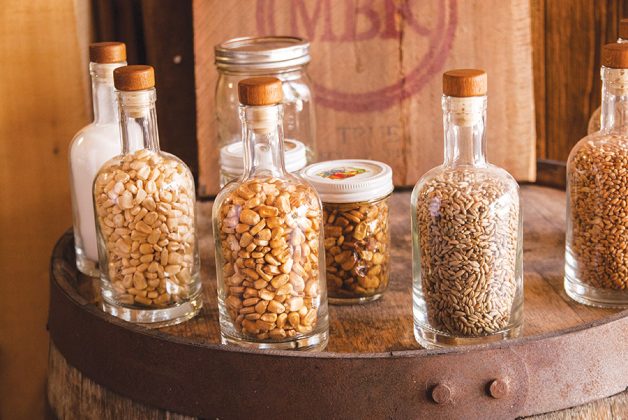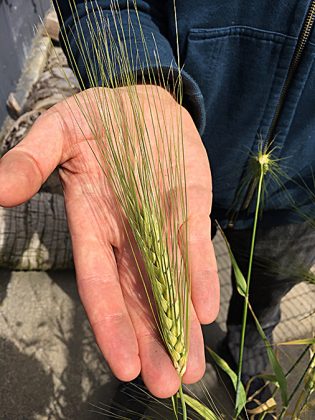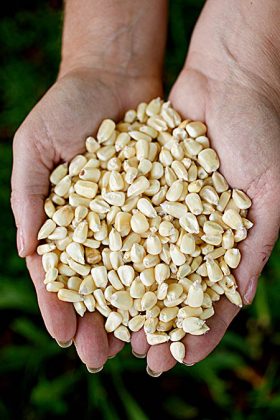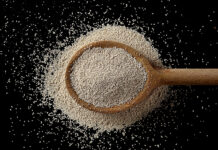American whiskey and, in fact, most American spirits of any type, are made from a combination of cereal grains. Regardless of their origin, however, all of these grains and even most fruits grown for use in beverage alcohol share some common migratory hallmarks. At some point, foraging humans stumbled upon a plant whose seeds or fruits didn’t make them violently ill or taste horrible; in fact, some of them even tasted good! Some tasted even better after a little spoilage took hold… or at least they felt better! You get used to the taste.
Over generations the most vigorous, abundant and nutritionally dense plants were chosen and their seeds saved, their scions grafted or their rhizomes split, while the weaker of their species were left to fall by the wayside where they were trampled underfoot and the birds of the air devoured them. At times, we even crossbred certain species to preserve the best traits of their offspring while leaving behind the worst. This selective breeding and hybridization gave us the rich genetic tapestry and wildly evocative names we see in seed and nursery catalogues today; Hopi Blue, Cosmonaut Volkov, Ailsa Craig, Esopus Spitzenberg, Fox Whelp (or Faux Whelp for you cider purists).
However positively human migration and proto-globalization originally aided biodiversity, the 20th century saw a massive contraction in crop species of every variety. Grains were bred solely for starch and gluten content. Grapes were bred solely for their transportability, their use as coloring aides and to boost alcoholic yield. Tomatoes were bred to be picked green, gassed with ethylene and delivered bright red, flavorless and mealy to every supermarket in America. These crops are grown to serve humankind’s machines and logistical needs more than to delight the palate. Crops are grown to address the demand of 7.5 billion hungry mouths but not the tastes and aesthetic preferences of a distinct culture. Crops were bred to survive proprietary chemical cocktails instead of a growing child’s nutritional needs. Crops were bred to grow in any climate, but not to reflect the best qualities of the land they are grown in. Fussy, flavorful, weirdly textured and shaped crops were out; homogeny and consistency were in.
In spite of this, however, we have selected certain crops to value above all others for their aesthetic qualities and even the way they extract the flavors and aromas of the land, locking in characteristics of regionality, seasonality and the agricultural sentiments of the people. I can think of no other crop that is grown globally for precisely these characteristics than the grape. Not only has humankind spread these gnarled, twisting vines across the globe, it has bent over backward to ensure their viability and vigor for future generations.
When a pest-induced blight affected the oenological agriculture of Europe in the 19th century, one of the most massive agricultural research projects man has ever undertaken commenced. The culprit was found, its predatory nature studied and an elegant solution developed. The Phylloxera insect, a North American transplant to mainland Europe, devastated wine crops across the continent for decades before it was even identified. Further study revealed its mechanisms for destruction and an intriguing phenomenon: North America’s native grape varietals were not affected by Phylloxera. The grapes had, over unnamed evolutionary epochs, developed a resistance mechanism to their insect neighbors. This trait made them perfect grafting bases for the otherwise imminently extinct Vitis vinifera grapes. Europe’s wine was saved by its distant American cousin. Global genetic traffic had created both a devastating problem and an elegant solution. It is highly likely, however, that had humans not been growing grapes for the purpose of beverage alcohol they may very well have fallen by the genetic roadside, perhaps to be carried to some verdant land free of Phylloxera, but most likely to become a distant memory of the once-pure world of legend.
So much effort, ingenuity and persistence is spent to preserve a crop of dubious human necessity: So much effort to ensure that we still have Pinot Noir, Riesling, Ugni Blanc and Chardonnay in, as much as possible, their historical form. Varietal character is of the utmost importance in wines as well as their distilled expressions: Cognac, Armagnac, Grappa. And rightly so.
Ask yourself this: When was the last time you bought a bottle of wine without knowing the varietal?
It seems an absurdity to not only know what grape or grapes form a wine’s base, but even what nation, region and even at times the specific vineyard it was grown in. Vintage, estate, Mise en Bouteille au Château. These are all terms alien to most other crops, yet critical to grapes and all indicating their agricultural provenance and purity.
Now, think to the last whiskey you had. What corn, rye or malt variety was it produced from?
Have you ever known a whiskey to announce its most important component by name? If so, it was almost certainly distilled in the last 10 years by some bearded, tattooed weirdo who took a long shot on what was probably a risky business decision. It was almost certainly from a grain grown within a stone’s throw of where our hero fails to shave every morning. Almost certainly grown by a crusty old farmer that had to hand-hold said beardo through the most elementary stages of crop husbandry. Almost certainly milled, fermented, distilled and casked with crossed fingers and a whispered prayer, “Dear lord, hear my pleas. Make this the greatest whiskey ever tasted… or at least not the worst.”
At this point I should talk about the variability of certain grain varietals, their fatty acid content and their effects on esterification. Or amino acids and how they affect the formation of congeners and how critical a role congener formation plays in quality considerations such as mouthfeel. I should cite research papers and show graphs and illustrations of molecular pathways. I should illustrate the consequences of the union of wood acids, alcohols and aldehydes and make comparisons to aromas and flavors reminiscent of tropical fruits and of putrescence. But you aren’t reading this on the john of the distillery tasting room for technical assistance (yeah, I see you pal). You are looking for ideas, inspiration and direction… or maybe just a light read to kill five minutes. You are plagued with grander questions like “What the hell is going to happen in whiskey in the next 10 years?” and “Where is there space to innovate such a grand and timeless product so intrinsically American and immutable?” and “What the hell did I get myself into?”
How does the modern distiller cope with such seemingly ineffable and unknowable conundrums? By taking comfort in the fact that whiskey never was and never will be static. I know this goes against the story spun in the commercials, but whiskey is an ever-changing product and, just like its genetic building blocks, almost unrecognizable in its current form. As with all other agricultural products, whiskey was heavily affected by not only the mechanization and commoditization of the 20th century, but was additionally dealt a unique blow with the road-to-hell of good intentions that was Prohibition. Though there are scant records available, the ones that are paint a picture of regionally favored historic grains and near-religious fanatical devotion to favored corn varieties thought to give the best flavor, aroma and even… “je ne sais quaff” they lent to the spirit (though we can now more or less “sais” what we je ne know at the time). Even the venerable single malt Scotch has seen iterative changes in favored barley varietals over the years. Nothing is historically accurate, everything is in flux.
If you want a picture of the future of American whiskey, look to our past. When the fidelity of whiskey was being threatened by unscrupulous adulterators, and the consumer was routinely being fed turpentine and iodine instead of fine Pennsylvania rye, Americans acted to preserve their heritage and the Bottled in Bond Act of 1897 was passed. Bottled in bond is, for all intents and purposes, analogous to “vintage” in wine. It even dictates that the distillate is all produced within a single “distilling season.” The consumer drove the Bottled in Bond Act and, mark my words, the consumer will drive the future of whiskey.
In fact, with the resurgence of craft spirits we are seeing an unprecedented level of consumer involvement. What was, for most people, a completely opaque process has now become something of an armchair sport with blogs and books and subreddits devoted to hashing out the finer qualities of spirits and determining their exact provenance. The farmer’s market has become a spirits tasting seminar in some cities, with farm distilleries vying for the chance to show off their process, their aspirations and their terroir.
I know, I used that word; forgive me. You may not want to hear this… but whiskey expresses terroir. The flavor of the land, the growing season and harvest conditions are all imparted into the spirit. It is clear that whiskey can be made from any grain grown anywhere. The vast majority of whiskey made in America is produced with grains with the poorest organoleptic qualities imaginable: livestock feed and the same stuff that high fructose corn syrup comes from. And what is already on the market is great whiskey—when compared to its similarly concocted peers. But what happens when distillers start showing off what their land and region can do? What happens when the bloggers and farmer’s market shoppers start asking about growing practices and varietals?
Don’t believe it could happen? It will. Just look at craft beer. The sheer diversity of offerings is staggering and classified by the raw materials employed. Even fermentation style has become a major talking point and differentiator. However, when I was a kid, fistfights would ensue over talking points as pedestrian as whether a beer tasted great or was less filling. OK, maybe I’m remembering a Super Bowl commercial; you get the point. We’ve come a long way. Why should we expect whiskey to stagnate? It won’t.
Still don’t believe it can happen? It already has. Beardo already took a risk and showed us that grains are, in fact, just like grapes… or any other raw material. They can be just as wildly variable in organoleptic qualities, just as expressive of terroir and just as interesting to the consumer as Pinot Noir. We as an industry have thrived on smoke and mirrors too long. The consumer is beginning to understand exactly what happens under that copper dome and they are coming to us, ready to ask questions, ready to be blown away.
Despite the similarities with other beverage alcohol producers, craft distillers have a huge advantage that no other sector has. One single and significant factor that is genuinely unique in craft spirits and only in this era: the diversity of products that are expected to be produced in a single distillery. In all of history, a distiller was almost always focused on one product type. Sure, there may be various expressions of that spirit type, but never before has a distiller—and I mean a Distiller, not one who assumes that title because of an industry position, but earns it through burns, midnight shifts babysitting a copper kettle and nights of lost sleep agonizing over attenuation—never before has a distiller had the opportunity to create such a diversity of products. A craft distiller is expected to not only master whiskey, but also gin, vodka, various brandies, liqueurs… all products with their own sets of challenges, techniques and spirituous expressions. the path is long, but one single factor will unite these products in success: The quality of their raw materials. If a vintner should agonize over the quality of the grape harvest (and they should), why should we ignore the same qualities inherent in our whiskeys?
So how does a distiller go about procuring these mysterious and ageless grains? By going back to the source; by starting with the farmer. Establishing a relationship with your local agrarians will pay dividends in ways you can’t even imagine and, unlike most commodities, prices can actually be more competitively priced locally than on the open market. But let’s be honest; farmers aren’t the best at self-promotion. It’s often difficult to know who owns the plot of land right next to your suburb, let alone get their contact info. Fortunately, the US has a fantastic array of agricultural extension offices, often operated by state universities, that can help. The USDA maintains a list of agricultural extension offices and partner land grant universities for every state… even D.C. Go to the National Institute of Food and Agriculture site and look at the Partners and Extension Map (https://nifa.usda.gov/partners-and-extension-map). These extension offices are an amazing resource for not only getting in contact with local agrarians but also offer education and training and can even aid producers with more mysterious things like grant writing and business development. Local grain purveyors can also be a great way to get in contact with farmers. They have to get their grains somewhere, right? Chances are they’ve spoken with farmers who want to develop relationships of just this sort.
Now you’ve found the farmer, but what about the grains themselves? In spite of the contraction of the industry in the 20th century, a few forward-thinking individuals and organizations realized the value of our genetic heritage and preserved it. Veteran groups like Seed Savers Exchange and Native Seeds/SEARCH, as well as newcomers like 46 Grain Company have dedicated themselves to scouring the earth for heritage grains and making them available to future generations. In addition, your university extension may already be conducting field trials to establish the viability of certain grains regionally. Cornell Cooperative Extension, for example, is doing extensive field trials with malting barley, a crop that was once crucial to New York agriculture and had all but vanished since Prohibition. In fact, many heritage grains were actually developed by those selfsame universities to withstand the rigors of the local growing conditions. The landscape is so vast and, at times, so obscured that no one person or organization is going to have all of the answers. But this is a good thing. It means that there are a thousand roads available to you, they just may not be well marked. But really, where would America be if we didn’t have the constantly pressing desire to explore the road less traveled?
Make no mistake, this is the dawn of the future and the future is locked in our genetic heritage. Ripe and ready for harvest. The consumer is dying for it. Who’s going to meet them for a drink?











